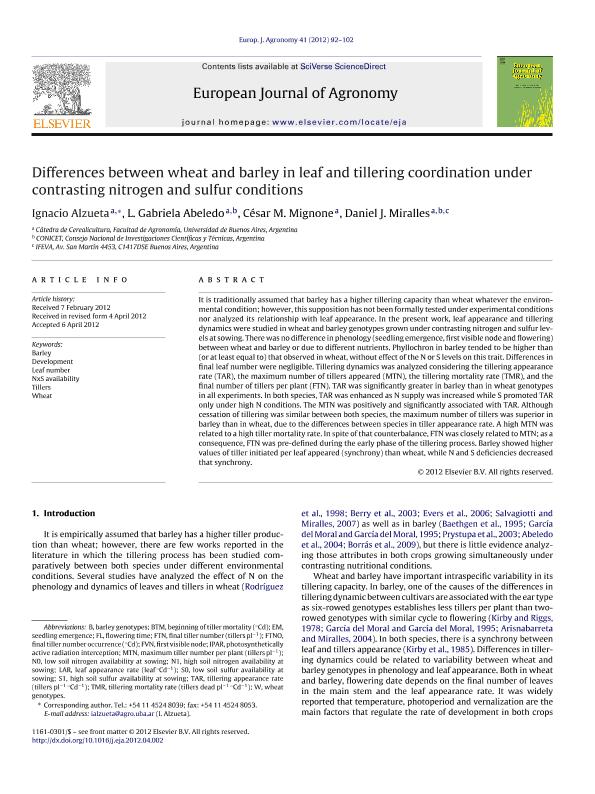Mostrar el registro sencillo del ítem
dc.contributor.author
Alzueta, Ignacio

dc.contributor.author
Abeledo, Leonor Gabriela

dc.contributor.author
Mignone, César M.
dc.contributor.author
Miralles, Daniel Julio

dc.date.available
2017-05-10T15:18:48Z
dc.date.issued
2012-08
dc.identifier.citation
Alzueta, Ignacio; Abeledo, Leonor Gabriela; Mignone, César M.; Miralles, Daniel Julio; Differences between wheat and barley in leaf and tillering coordination under contrasting nitrogen and sulfur conditions; Elsevier Science; European Journal Of Agronomy; 41; 8-2012; 92-102
dc.identifier.issn
1161-0301
dc.identifier.uri
http://hdl.handle.net/11336/16196
dc.description.abstract
It is traditionally assumed that barley has a higher tillering capacity than wheat whatever the environmental condition; however, this supposition has not been formally tested under experimental conditions nor analyzed its relationship with leaf appearance. In the present work, leaf appearance and tillering dynamics were studied in wheat and barley genotypes grown under contrasting nitrogen and sulfur levels at sowing. There was no difference in phenology (seedling emergence, first visible node and flowering) between wheat and barley or due to different nutrients. Phyllochron in barley tended to be higher than (or at least equal to) that observed in wheat, without effect of the N or S levels on this trait. Differences in final leaf number were negligible. Tillering dynamics was analyzed considering the tillering appearance rate (TAR), the maximum number of tillers appeared (MTN), the tillering mortality rate (TMR), and the final number of tillers per plant (FTN). TAR was significantly greater in barley than in wheat genotypes in all experiments. In both species, TAR was enhanced as N supply was increased while S promoted TAR only under high N conditions. The MTN was positively and significantly associated with TAR. Although cessation of tillering was similar between both species, the maximum number of tillers was superior in barley than in wheat, due to the differences between species in tiller appearance rate. A high MTN was related to a high tiller mortality rate. In spite of that counterbalance, FTN was closely related to MTN; as a consequence, FTN was pre-defined during the early phase of the tillering process. Barley showed higher values of tiller initiated per leaf appeared (synchrony) than wheat, while N and S deficiencies decreased that synchrony.
dc.format
application/pdf
dc.language.iso
eng
dc.publisher
Elsevier Science

dc.rights
info:eu-repo/semantics/openAccess
dc.rights.uri
https://creativecommons.org/licenses/by-nc-nd/2.5/ar/
dc.subject
Barley
dc.subject
Nxs Availability
dc.subject
Tillers
dc.subject
Wheat
dc.subject.classification
Agricultura

dc.subject.classification
Agricultura, Silvicultura y Pesca

dc.subject.classification
CIENCIAS AGRÍCOLAS

dc.title
Differences between wheat and barley in leaf and tillering coordination under contrasting nitrogen and sulfur conditions
dc.type
info:eu-repo/semantics/article
dc.type
info:ar-repo/semantics/artículo
dc.type
info:eu-repo/semantics/publishedVersion
dc.date.updated
2017-05-09T18:03:19Z
dc.journal.volume
41
dc.journal.pagination
92-102
dc.journal.pais
Países Bajos

dc.journal.ciudad
Amsterdam
dc.description.fil
Fil: Alzueta, Ignacio. Universidad de Buenos Aires. Facultad de Agronomía. Departamento de Producción Vegetal. Cátedra de Cerealicultura; Argentina. Consejo Nacional de Investigaciones Científicas y Técnicas; Argentina
dc.description.fil
Fil: Abeledo, Leonor Gabriela. Universidad de Buenos Aires. Facultad de Agronomía. Departamento de Producción Vegetal. Cátedra de Cerealicultura; Argentina. Consejo Nacional de Investigaciones Científicas y Técnicas; Argentina
dc.description.fil
Fil: Mignone, César M.. Universidad de Buenos Aires. Facultad de Agronomía. Departamento de Producción Vegetal. Cátedra de Cerealicultura; Argentina
dc.description.fil
Fil: Miralles, Daniel Julio. Universidad de Buenos Aires. Facultad de Agronomía. Departamento de Producción Vegetal. Cátedra de Cerealicultura; Argentina. Consejo Nacional de Investigaciones Científicas y Técnicas. Oficina de Coordinación Administrativa Parque Centenario. Instituto de Investigaciones Fisiológicas y Ecológicas Vinculadas a la Agricultura. Universidad de Buenos Aires. Facultad de Agronomía. Instituto de Investigaciones Fisiológicas y Ecológicas Vinculadas a la Agricultura; Argentina
dc.journal.title
European Journal Of Agronomy

dc.relation.alternativeid
info:eu-repo/semantics/altIdentifier/doi/http://dx.doi.org/10.1016/j.eja.2012.04.002
dc.relation.alternativeid
info:eu-repo/semantics/altIdentifier/url/http://www.sciencedirect.com/science/article/pii/S1161030112000603
Archivos asociados
